Over the last few years, Africa has seen a steady growth in people going vegan. It might come as a surprise to many that the pre-colonial African diet was plant-based, given the high consumption of meat that we currently see. So, Africans going vegan is a return to our roots.
Traditional African meals consisted of yams, cassava, grains and vegetables. Food was prepared with local herbs and spices that not only taste good, but are also medicinal. Meat and fish were for special occasions for people who could afford it as local people were mainly farmers, and animal husbandry was not yet a thing. Regular meat is a colonial influence that has seen people buying into the idea that it is a social economic symbol of wealth and status.
Going vegan was relatively ‘easy’ for me and this is coming from someone who had truly indulged in meat in the UK for nearly 2 decades. Growing up in an Igbo household in Nigeria in the 80s, my family did not eat a lot of meat. We often used mushrooms, Achara (Elephant grass) and Akpuruakpo egusi (Melon seed cake) as meat substitutes. Therefore, I was able to ‘veganise’ my meals and not feel like there was anything missing when I went vegan 4 years ago.
Last year, I did a self-funded vegan media tour of Nigeria and participated in a celebrity national cooking competition with top movie stars. It was ground-breaking as it is the first time veganism has been represented in a more prominent way on mainstream platforms. On my team, I had Chef Bola who is the founder of Veggie Victory alongside her husband, Hakeem Jimo. Veggie Victory is the first 100 % vegan restaurant in West Africa. I was also able to meet with Bolanile who founded Vegan in Nigeria (an association for vegans living in Nigeria) and the first 100% alkaline vegan restaurant in Nigeria. Through them I was able to meet other vegans and talk about the growth of veganism. I had come to realise that Nigerians are embracing a more vegan lifestyle and more vegan restaurants are springing up all over the country.
I believe it is time to embrace traditional African food. These recipes below seek to introduce you to native African dishes. It is hoped that you will venture into a new world and experience true flavours. Africa has some of the most flavoursome food in the world yet it is not so popular in the vegan world. When you make these dishes for yourself, you will realise why this is so crazy.
I would like to encourage you to bring the African continent to your home by trying the recipes that I have listed below. Most of the ingredients can easily be found from continental food shops, large supermarkets or from uziizia.com (Instagram @uziiza).
Kelewele (Spicy Fried Plantain)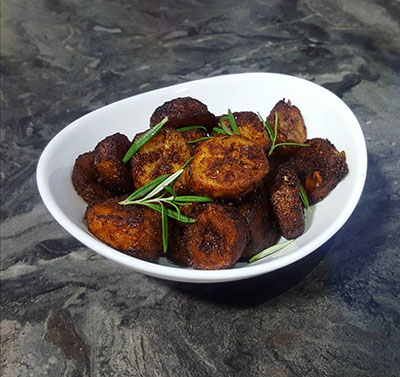
Ingredients
- 2 ripe (yellow) plantains
- 3 tsbs oil of choice
- 1 tsp mixed spices
- 1 tsp mixed herbs
- ½ tsp powdered ginger
- ¼ tsp powdered garlic
- Salt to taste
Method
- Take skin off plantains, slice into slim chunks, mix in seasonings and set aside.
- Using a non-stick skillet or frying pan over medium heat and add oil.
- Add plantains, in a single layer, into the hot heated oil. Cook on both sides for two to three minutes or until golden.
- Transfer cooked plantain on to a plate containing paper towels to drain the oil.
- Serve
Ji Mmiri Oku (Yam Pepper Soup) 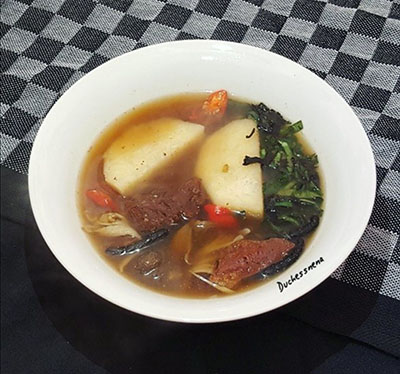
Ingredients
- ¼ of a medium yam.
- 1 scotch bonnet pepper.
- 1 pod of uda*
- ¼ cup of shiitake mushrooms
- 1tsp uziza spice*
- ¼ tsp of ogiri /lru*
- 1 vegetable stock cube
- 2 medium carrots
Method
- Peel skin of the yam and cut into small cubes
- Fill a medium pot half way with water and put on medium heat to boil.
- Cut your washed carrots and mushrooms into chunky bits and set aside.
- Put washed yam cubes into the boiling water and cook for 10 minutes. Add the mushrooms and carrot. Cook for a further 5 minutes.
- Add stock cube, ogiri, uziza and salt. Cook for a further 1 minute.
- Serve hot in a big bowl.
Egusi Soup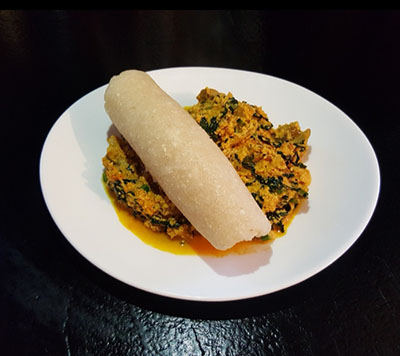
Ingredients
- 1 cup of ground egusi (melon) seeds.
- 2 tablespoons of red palm oil (ethical).
- 2 scotch bonnet pepper
- Salt to taste
- A cup of fresh sliced spinach
- ½ cup of uziza leaves (optional)*
- 1 vegetable stock cube
- ¼ teaspoon of ogiri/iru*
- 1 cupof sliced button mushroom
Method
- In a medium cooking pot, add 4 cups of water, ground egusi, palm oil, seasoning cube, pepper and salt to taste and boil over medium heat. Bring to boil, stirring occasionally to avoid sticking to pot.
- When content becomes a thick broth, add your vegetables and mushrooms.
- Cook for a minute and serve.
- Can be eaten on its own as a soup or a sauce for rice, potatoes or yam.
Suya (Spicy Kebab)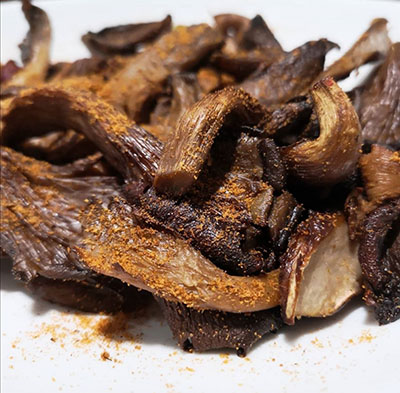
Quick and easy healthy snack
Ingredients
- 2 cups of oyster mushrooms
- 1 tsp of dried red chillies
- 2 tsp finely ground roasted peanuts (skip this if allergic)
- 1 tsp paprika.
- ¼ tsp salt.
- ½ tsp ground ginger
- ½ tsp garlic powder
- ½ tsp onion powder
- 1 bouillon cube
Method
- Wash mushroom and dried with paper towel.
- Spread out on a baking pan and put in a preheated medium grill. Mushrooms can dry up very quickly so check regularly and turn on either side to avoid burning. Cook for 10 minutes and set aside.
- Mix chillies, paprika, garlic, ginger, onion, salt and bouillon cube in a dry bowl.
- Transfer mushrooms in a plate and sprinkle mix to taste
Stew (Tomato Sauce) 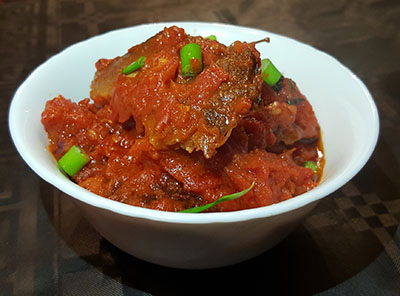
This most versatile sauce is a great accompaniment to rice, potatoes, pasta, beans, yam and plantains.
Ingredients
- 2 cans of chopped tomatoes
- 1 large red bell pepper
- 1 onion
- ½ clove of garlic
- ¼ of ginger finger
- 3 chillies or 1 scotch bonnet
- 2 tbs of tomato puree
- 4 tbs of oil of choice
- Salt
- ¼ tsp curry powder
- ¼ tsp of mixed herbs (alternatively use fresh herbs)
- 1 stock cube
Method
- In a blender or food processor, add 1 cup of water, chopped tomatoes, chillies/scotch bonnet, bell pepper, garlic and ginger. Blend till fine and set aside.
- Chop onions and set aside.
- Add oil to a dry pan and put on medium heat. Heat oil for a minute and then add onions. Stir onions until golden.
- Add blended mix and stir. Let content reduce for 15 minutes, making sure you stir regularly to reduce burn, then add tomato puree and cook for a further 5 minutes. (At this point you can add another cup of water if sauce is too thick for your liking)
- Add curry powder, herbs, stock cube and salt to taste. Mix in well and cook for 1 minute.
- Serve
Jollof Rice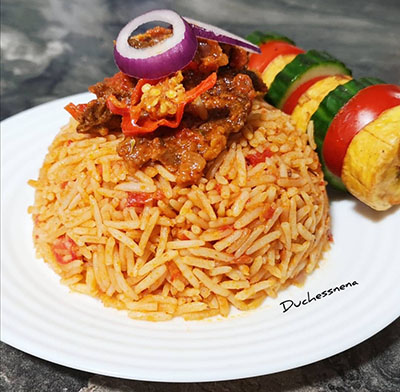
Ingredients
- 2 cups of parboiled long grain rice
- 2 cans of chopped tomatoes
- 1 large red bellpepper
- 1 onion.
- Half clove of garlic
- ¼ of ginger finger
- 3 chillies or 1 scotch bonnet
- 2 tbs of tomato puree
- 4 tbs of oil of choice
- Salt to taste
- ¼ tsp curry powder
- ¼ tsp of mixed herbs (alternatively use fresh herbs)
- 1 stock cube
- 1 tbs all purpose seasoning
- 1 bay leaf
Method
- In a medium pan, add parboiled, cover with water and bring to boil. Take off heat and rinse thoroughly in cold water. Drain water and set aside.
- Follow instructions on how to make tomato stew.
- Add rice, bay leaf, all purpose seasoning and 3 cups of water to stew. Cover pot and cook on low to medium heat for 15 - 30 minutes until dry. Check regularly to make sure the rice does not dry out before being done.
- Once rice is soft, use a wooden spoon to mix properly and serve.
Beans Pottage (Red Red)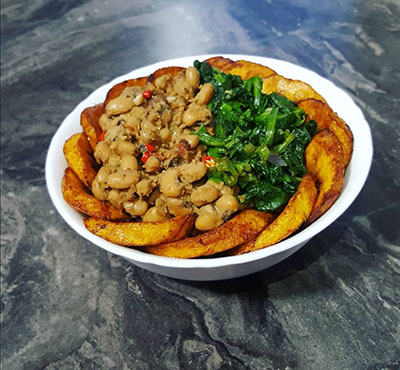
Can be eaten by itself with fried plantain and vegetable or as a sauce for rice.
Ingredients
- 3 cups of black eyed peas/beans
- ¼ cup of palm oil (optional)
- 2 fresh tomatoes
- 1 scotch bonnet pepper
- 1 red onion
- 1 large bell pepper
- 1 vegetable cube
- ½ tsp of iru*
- Salt to taste
Method
- Soak beans in cold water over night to remove phytic acid.
- Wash and put in a pot filled with water. Cook on high heat for 40 minutes the beans or until tender.
- In a blender, add the tomatoes, onions, scotch bonnet, bell pepper, iru and 1 cup of water. Blend till pureed and transfer into the cooking beans. Add salt to taste.
- Add the oil (optional).
- Cook for a further 15 minutes.
- Serve.
*Iru and ogiri (fermented oil seeds used for seasoning). Uziza (piper guineense). Uda (grains of paradise).
Nena Ubani (a.k.a Duchess Nena) is a UK-based vegan chef and master herbalist who specialises in African cooking. Nena is the founder of uziiza.com, the UK's first African vegan online store. She uses her knowledge of herbs to create dishes that not only taste good but also provides healing to the body. Nena also hosts regular pop-ups/dinner clubs. Follow her on lnstagram for updates and recipes @duchessnena @uziiza.
The views expressed by our bloggers are not necessarily the views of The Vegan Society.

